Technology
How I Built a Printable Product Store from Scratch Using an AI Coloring Page Generator?
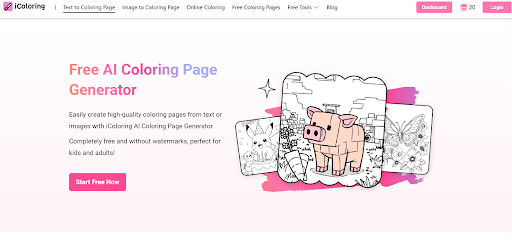
Let me start with a confession: I’m not a designer, and I’ve never considered myself particularly “creative.”
In fact, when I first stumbled across the idea of selling printable products online, I thought it sounded like something other people do—you know, the artsy ones with beautiful Instagram feeds and pro-level tools.
But then I found this tool called an AI coloring page generator, and everything changed.
It was fast. It was free. And it made me realize—I actually can do this.
So if you’ve ever scrolled through Etsy and wondered, “Could I sell something like this?”—this story’s for you.
Spoiler alert: You absolutely can.
And the best part? You don’t need to draw a single line.
Let me show you how I built my first printable product store, completely from scratch—with a little help from AI.
Why Printables? Why Now?
Let’s be honest—if you’ve ever typed “side hustle ideas” into Google (like I did), you’ve probably seen printable products come up again and again.
And there’s a good reason for that.
Printables are kind of magical.
You create them once, upload them to a marketplace like Etsy or Gumroad, and then—boom—they can be sold over and over again without ever touching inventory or packaging.
No shipping.
No late-night customer service.
Just a passive income stream that works while you sleep (or scroll TikTok, let’s be real).
What really caught my eye, though, was the coloring page niche.
It’s way more versatile than I thought—there are name coloring pages, holiday-themed sets, even adult mindfulness pages. And people are actually buying them.
I saw shops with hundreds of sales from just a few coloring books. That’s when I realized:
“Okay… if I could find a way to make these without drawing everything myself, maybe I’m onto something.”
Spoiler again: that’s where the AI Coloring Page Generator comes in.
It turns words into line art. Yep, really. I’ll show you how in a second.
From Idea to First Product — Thanks, AI
So here’s what I did.
I opened a blank notebook (okay, it was a Google Doc), and started brainstorming:
- What kind of coloring pages might people want?
- What themes are trending right now—unicorns? Dinosaurs? Summer vibes?
Then I headed to Pinterest and Etsy to do a little spying.
Pro tip: just search “printable coloring pages” and filter by “bestseller.” You’ll see what’s hot in seconds.
Once I had a few ideas in mind, I jumped over to icoloring.ai.
This is the AI Coloring Page Generator I mentioned earlier. You can literally just type something like “a kawaii cat eating ice cream” or “Easter bunny with flowers,” and it turns that into clean, printable line art—in seconds.
You can even choose different styles and page sizes.
I picked A4 PDF format (easy to print!), downloaded it with no watermark, and boom—I had my first digital product.
I didn’t stop there. I tried their Image to Coloring Page tool too. Just uploaded a cartoon pic of a fox, and it gave me a perfect outline version in seconds.
Seriously—this tool made me feel like a pro, without the pressure of being one.
Why AI Tools Like This Are a Beginner’s Best Friend
Here’s the truth: I would’ve never started this little store if I had to draw everything by hand.
Between work, family, and everything else—who has the time to learn illustration?
But the AI coloring page generator changed the game for me.
It wasn’t just a shortcut—it was like having a creative assistant that worked 24/7, didn’t complain, and never charged me a dime.
Here’s what makes it beginner-friendly:
- Text to Coloring Page: Just describe what you want. “Astronaut dog on the moon”? Boom. You got it.
- Image to Coloring Page: Upload a photo or drawing, and it instantly turns it into line art.
- Multiple styles: You can go cute, realistic, cartoonish, or simple outlines—whatever suits your store’s vibe.
- Free, no watermark, high-quality PDF: Sounds small, but that made everything easier to sell.
It even has an AI coloring feature—so I can test how my pages might look colored in, which helps when making preview images for the product listings.
Basically, it let me skip the technical stuff and jump straight into creating and selling.
That’s a big deal when you’re just starting out and want to feel like you’re moving forward.
My Results, My Lessons — And Why You Could Do It Too
So, how did it go?
Honestly? Way better than I expected.
I uploaded my first few AI-generated coloring pages to Etsy, listed them for $2–$4 each, and within a week—I got my first sale.
It wasn’t much, but it felt huge.
Then came more: a couple of themed bundles (I used AI Coloring Page Generator to make a Halloween set and a “pets in costumes” pack), and a few custom name coloring pages.
By the end of my first month, I had sold 22 items. Not life-changing money, but enough to prove this idea actually works.
More importantly, I wasn’t burning out.
I wasn’t spending hours designing, or emailing customers back and forth. I let the tools handle the hard parts so I could focus on learning what sells—and what doesn’t.
And honestly? If I can do this—with no design skills, no background in art or e-commerce—literally anyone can.
That’s the power of smart, free tools like the one I used.
AI Coloring Page Generators don’t just help you create—they remove the reasons you never started in the first place.
You Don’t Need to Be an Artist—Just Curious Enough to Try
If you’re like me—someone with a few creative ideas but no idea where to start—this might be your sign.
You don’t need to be an illustrator.
You don’t need to invest in expensive tools or spend months learning design software.
You just need one thing: the willingness to test and play.
That’s what AI Coloring Page Generators like icoloring.ai are built for.
Whether you want to start a digital product shop, make printables for your kids, or just explore something fun on a rainy weekend—this is one of the easiest and most accessible tools out there.
And hey—if you end up making a few bucks along the way, even better.
Try it.
See what you can create in five minutes.
Who knows? This little experiment might just turn into something big.
Technology
Top 6 Cheap Residential Proxies: Saving Your Budget Easily

We all want the power of residential proxies for things like sneaker copping or market research, but that price tag can be scary. I’ve been there, staring at my screen, torn between burning a hole in my pocket or settling for a cheap option that might conk out mid-task. It’s frustrating. If you’re nodding along, you’ve landed in the right spot. I’ve tested a bunch of services to find that sweet spot where cost meets performance. Stick with me, and I’ll break down the top cheap residential proxies that actually work.
Why Choose Residential Proxies over Other Types?
So, why all the buzz about residential proxies? Think of it this way: datacenter proxies are like wearing a neon sign that says “I’M A BOT,” while residential proxies blend in with the regular crowd. They use IP addresses from real devices in real homes, making your online requests look completely normal. This type of IP source is a game-changer. It helps you bypass tough geo-blocks and avoid getting your accounts flagged or banned. For tasks like ad verification or accessing localized content, they’re simply unbeatable.
Top 6 Cheap Residential Proxies for Your Tight Budget
Now, it is time to get into the good stuff. Here’s my handpicked list of the best affordable residential proxy providers that deliver solid value without the crazy costs.
Top 1. IPcook
IPcook is my personal favorite and the one I use most often. It just hits that perfect balance of price and power. For $3.2 per GB, you get premium features that are often missing from other affordable residential proxy services. A huge plus for me is that their traffic doesn’t expire. Any unused data rolls over to the next month, which saves me money and stress. During my tests, the speeds were consistently fast, and the connections were rock-solid.
What really sold me was the control. You can fine-tune the IP rotation per request or per interval to your heart’s content. If you need a consistent IP address, IPcook also suffices by allowing you to set sticky sessions that can last up to 24 hours. No matter which type of control you want, it’s all there. It’s a top-tier choice for anyone looking for the best cheap residential proxies.
- Elite-level anonymity that passes strict checks.
- Highly flexible rotating or sticky IP sessions.
- Massive pool of 55M+ IPs across 185+ regions.
- Simple setup with great support for scripts and tools.
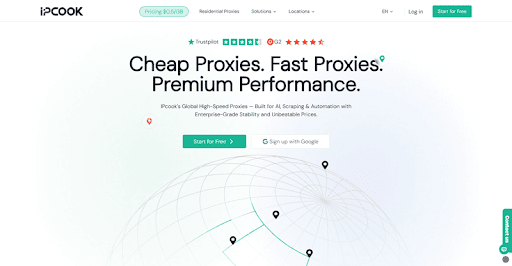
Top 2. DataImpulse
DataImpulse is the budget king, no doubt. If your primary concern is cost, this is one of the cheap rotating residential proxies out there, with prices starting at just $1 per GB. They offer a decent network and basic features that can handle light tasks. I’ve used them for simpler jobs where top-tier speed wasn’t critical.
However, you get what you pay for. I noticed the speed and connection stability weren’t as reliable as with other providers like IPcook and NetNut. There were occasional timeouts, which could be a deal-breaker for time-sensitive automation. It’s a decent option if your budget is extremely tight and your needs are basic, but you need to be cautious when you are dealing with a large-scale project.
- Extremely low-cost entry point.
- Adequate for basic browsing and data collection.
- Straightforward user dashboard.
- Offers both static and rotating options.
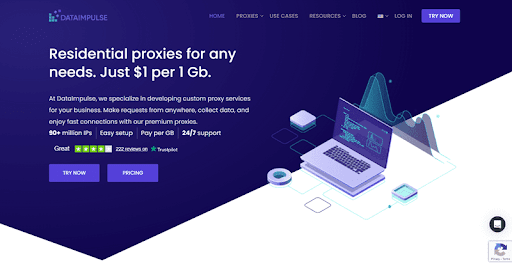
Top 3. Webshare
Webshare is another popular option on my list of affordable residential proxies. They offer a good range of features and a solid network. Priced at $3.5 per GB, they are a direct competitor in the cheap residential proxy market. I found their proxy setup to be quite easy, and they offer a generous number of free proxies to start with. This way, you can try out its performance before you decide to commit.
The main drawback for me is their traffic policy. Unlike IPcook, your unused data gets wiped clean at the end of the month. This “use it or lose it” model can be inefficient if your workload varies. It’s a solid service, but the lack of data rollover is a significant downside in my book.
- Generous 10 free proxies for testing.
- User-friendly platform and API.
- Good overall performance and reliability.
- Supports multiple authentication methods.
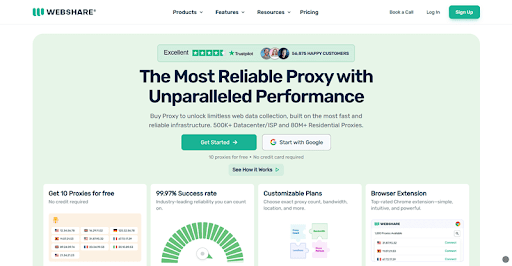
Top 4. Rayobyte
Rayobyte has built a strong reputation in the proxy space, and its residential network is robust. I appreciate their transparent, flat-rate pricing of $3.5 per GB, whether you buy 1GB or 49GB. This simplicity is great for individuals or small companies that watch their budgets closely. In addition, Rayobyte’s proxies are high-quality and work well for demanding tasks like large-scale data scraping.
On the flip side, their geographical coverage isn’t as extensive as some others on this list. If you need IPs from very specific or less common countries, you might find their pool a bit limited. Though the coverage might not suit everyone’s needs, they are a trusted provider of affordable rotating residential proxies.
- Consistent and reliable proxy performance.
- Simple, flat-rate pricing structure.
- Strong focus on ethical proxy sourcing.
- Helpful customer support team.
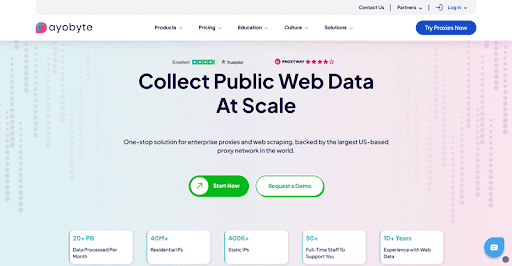
Top 5. NetNut
NetNut is another great competitor in the cheap proxy battlefield. At $3.53 per GB, their pricing is competitive with other best cheap residential proxies. With website unblockers and scraper APIs available, it is definitely a powerhouse, especially for heavy-duty, large-scale data scraping. They use unique network technology that can offer great stability for specific use cases. Therefore, their service is professional and geared towards businesses.
The biggest hurdle with NetNut is their minimum purchase requirement. You can’t just buy a single GB; you have to commit to a larger package, starting at 28GB. This makes it less accessible for individual users or small projects. It’s a premium service with a premium entry point.
- Excellent for high-volume, professional scraping.
- Stable and fast network infrastructure.
- Advanced features for enterprise clients.
- Strong performance in targeted regions.
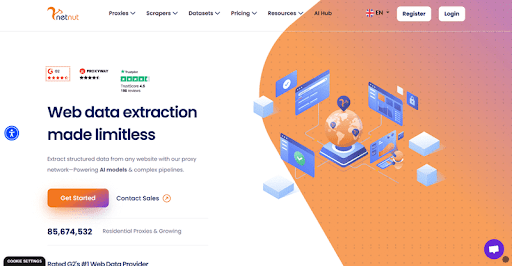
Top 6. MarsProxies
Now comes the last item on the list of best cheap residential proxies. MarsProxies positions itself as a premium provider, and you can feel it in their service quality. Their network is reliable and their connections are secure. I was impressed with the uptime during my tests. They are a solid choice if reliability is your top priority.
However, this quality comes at a cost. At $4.99 per GB, they are the most expensive option on this list. For me, the price is a bit steep compared to the value offered by others like IPcook. I’d only recommend them if your budget is flexible and you absolutely need their specific feature set.
- High reliability and excellent uptime.
- Quality customer service.
- Good for sensitive business tasks.
- Flexible authentication options.
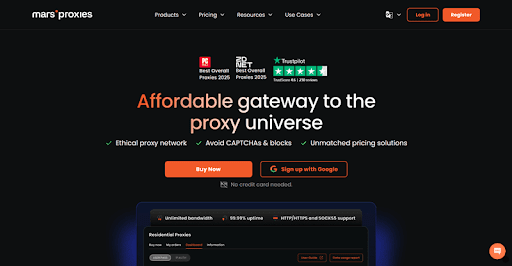
How to Select the Best Cheap Residential Proxy?
With so many options, how do you pick the right one? Don’t just look at the price per GB. You need to dig a little deeper to find a service that won’t let you down. Based on my testing, here are the key things I always check before committing.
- Test the Speed: Always run a speed test. A slow proxy is useless. Look for providers that publish their average response times.
- Check the IP Pool: A large, diverse pool of IPs is crucial. It prevents overuse and increases your success rate when accessing geo-restricted content.
- Review Pricing Structure: Look beyond the headline price. Check if traffic expires and if there are any hidden fees or minimum commitments.
- Prioritize Anonymity: Ensure the provider offers elite-level anonymity. Your requests shouldn’t leak any proxy-related headers if you want to remain completely unseen online.
- Utilize Free Trials: A free trial or test credits are your best friend. It lets you verify the service’s performance with your own tools and workflows.
FAQs About Cheap Residential Proxies
Q1: Which is the best cheap residential proxy?
Honestly, the “best” one depends entirely on your specific needs and budget. Some are cheaper but less reliable, while others are more powerful but cost a bit more. If you ask for my personal pick, I’d go with IPcook. Its mix of affordable pricing, stable performance, and flexible features makes it the most well-rounded and reliable option for most people.
Q2: Are cheap residential proxies safe to use?
Generally, yes, if you stick with reputable and reliable cheap residential proxy providers. The real risk comes from using suspiciously cheap or free services. These can be slow, unstable, and might even log and sell your data. It’s always worth paying a little more for a provider you can trust with your online security.
Final Words
Finding good and cheap residential proxies doesn’t have to be a nightmare. The key is to balance cost with the features you truly need. From my hands-on testing, services like IPcook really stand out by offering premium quality without the intimidating price tag. I hope this breakdown helps you cut through the noise and find a service that works perfectly for you and reduces your budget.
Technology
The Rise of Paid Telegram Communities: How Creators Are Monetizing Group Chats
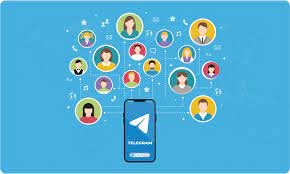
In recent years, Telegram paid channels and VIP paid groups have become one of the most effective ways for creators to build loyal audiences—and earn a revenue stream for their time, insights, and content. Unlike traditional social media, Telegram enables creators to establish intimate, exclusive communities where members can engage directly, learn, and connect.
From trading signals and crypto insights to coaching and niche education, Telegram’s flexibility has made it the go-to hub for subscription-based communities. But the real question is: how do you monetize a community effectively without spending hours managing payments, renewals, and access?
The Shift Toward Exclusive, Paid Communities
Telegram has evolved beyond a simple messaging app. For many creators, it’s now a business platform. People no longer just join groups—they subscribe to private spaces where they can get real value. This trend has exploded because Telegram offers something other platforms lack: simplicity, privacy, and automation.
Instead of relying on crowded Facebook groups or algorithm-heavy apps, creators are turning to paid Telegram groups and channels where they have full control. It’s like owning your own membership site—without the tech headaches.
Monetization Made Easy with InviteMember
If you’re wondering how creators actually run their Telegram paid channels, the answer often starts with the InviteMemberBot.
InviteMember is a powerful membership management system designed specifically for Telegram. It helps creators automate everything—from accepting payments to granting access to private groups or channels. The beauty is that InviteMemberBot isn’t a subscription bot itself, but rather an intelligent management platform to create your own subscription bot and business landing page, and connect your Telegram community with your payment processor.
Here’s how it works:
- You connect your Telegram bot and community.
- Set up your plans—monthly, annual, or even lifetime access.
- InviteMember handles the automation: once someone pays, they’re added to your paid Telegram groups and channels.
- If they don’t renew, the system automatically removes access.
It’s that seamless. No spreadsheets. No manual tracking. Just smooth, automated membership management.
Many creators share their Telegram paid channels link directly through InviteMember’s checkout page, turning social followers into paying community members in seconds.
Why Creators Are Choosing Telegram for Paid Memberships
- Global Audience Reach – Telegram’s international popularity means creators can sell subscriptions worldwide.
- Direct Connection – No algorithms or middlemen—just authentic community interaction.
- Low Overhead – Running a VIP paid group on Telegram is cheaper than building and maintaining a website.
- Automation Ready – Platforms like InviteMember remove all the manual work.
Enhancing Support with SUCH bot
For creators who want to offer quick support or collect feedback inside Telegram, the SUCH bot is a simple yet powerful option. It’s a bot builder that lets you create support or feedback chatbots with ease—no coding needed. You can even enable AI-powered automatic replies to handle common member questions or guide new subscribers.
While InviteMember takes care of subscriptions and access, SUCH bot helps you stay responsive and organized by keeping support conversations running smoothly right inside Telegram.
Building a Sustainable Income Stream
The rise of Telegram paid channels marks a shift in how creators earn online. Instead of chasing ad revenue or affiliate links, they’re turning their expertise into recurring income. Whether you’re a fitness coach, educator, or market analyst, monetizing a community through a paid Telegram setup can be the simplest, most direct business model you’ll ever launch.
The formula is straightforward:
Engaged audience + quality content + smart automation = sustainable income.
Final Thoughts
Paid Telegram communities are no longer a niche trend—they’re a growing economy. Tools like InviteMember make the process of setting up and managing these communities effortless, while the SUCH bot keeps member communication seamless through AI-powered support.
If you’ve ever thought about turning your Telegram following into a revenue stream, now’s the time. With a well-structured paid Telegram group, an automated setup, and authentic engagement, your community can become both a source of impact and income.
Technology
From Home to Hills — My First Long-Distance Camping Trip on an Electric Bike

Something is just magical about the thought of getting out of the city, the noise, the rush, the constant traffic, and going out into the hills, where it is time to slow down. I had always wanted to have a visit which would bring me back to the world of nature, but I wanted to do something different this time. No automobile, no company, no one, only me, my mind, and the open highway.
That is when I encountered the idea of the electric dirt bikes. I had heard about them previously, but never thought that one could cope with a long-distance ride. Curiosity became excitement, and within days, I had already decided to go camping with my first-ever camping trip, and all I needed was an electric dirt bike to be my transport.
The notion was insane — to ride a battery-powered bike to the hills out of my home. Yet I longed inside myself to have the excitement of something new. And when I was filling my camping bag and closing my jacket, I never thought this would be among the most memorable moments in my life.
The Road Begins -New Way of Travelling
So, I was instantly on the road. I knew how this ride was going to be different. The electric dirt bike was hardly hearable, and the acceleration was felt instantly and in a very strong manner. The highway was endless, and all the twists and turns were a challenge to navigate.
I sped over silent farms, little rivers, and mountain curves over which the morning mist rushed on the earth. No fuzziness or engine sound, they were on a fuel bike; the only thing one heard was the wind gently swirling around and the tires gently rolling on the road.
That is when I became aware of the real beauty of electric travel: it is silent, immobile, and connected with nature.
Climbing Higher: The Freedom of Electric Power
I was shocked to find how easy it was to ride the bike on steep roads as I started riding uphill roads. In most cases, these climbs need some force- either on the engine or the rider. However, the electric dirt bike seemed to ride up as though it was made to face this challenge.
Each thrust of the throttle enabled me to feel the power at my feet. No indecision, no struggle–but pure hard silence. I stopped in between to get some of the snapshots and realised how clean the air was. No puffing-out of smoke, no scraping of gears, just me, and the cry of birds in the valley.
The Hero of the Journey: HappyRun 6500W Electric Dirt Bike G300 Pro -2025

The main thing that caught my attention with this unforgettable journey was the HappyRun 6500W Electric Dirt Bike G300 Pro 2025, which is the real highlight of my trip. It is not just a bike, but a high-performance and missionary bike that would surely be ridden by everybody who desires to experience the freedom of roaming out of the door. Her motor is very strong, with 6500W, and thus, has a tremendous torque, and this allows it to climb a hill or rather rocky mountains, which are not stable. It accelerates fastest, and the top speed is 50 mph which is mind-boggling, but it is a well-balanced and stable car.
The most impressive thing to me was the lithium battery that was 72 V 30 Ah, which enabled the bike to cover a course with almost 70 miles of range, given it had a single cycle of charge. That is the type of reliability that we would fall in love with in the eyes of those of us who are going on long-distance adventures, such as myself.
Its suspension is powerful and capable of going through all the bumps, and its brakes are fast, and they can work even in rough areas. It is not that delicate, but it is modern in fashion and a head-turner anywhere.
Mountain Mornings and Camping Nights
The electric dirt bike had brought me to the place where nature was the master; there was no pollution, no crowd, only millions of stars above me. I sat on a small campfire and wondered how this travel was so dissimilar to conventional travel.
On the following morning, I rode the bike to see what was around. What was new in each direction was a muddy slope and a rocky turn, and hidden falls. The bike managed to cope with everyone like a professional, which led to the conclusion that adventure and technology can be the most successful combination.
Why Everybody has to visit an Electric Dirt Bike Adventure
You are denying yourself something special in case you have never had an electric bikes for sale. You can either camp or simply go outdoors; however, you will discover that with an electric dirt bike, every second will be thrilling and liberating.
Now you can travel further than sightseeing more, and yet have energy to appreciate your destination. And as there are such a great number of electric dirt bikes that are being sold today, there has never been a better moment to have an adventure of your own.
The Future of Electric Adventures
Nature is not interrupted, and he can be viewed without disturbing it, with no fumes, no noise, and basic exploration. The new electric bikes for sale in the market are no longer associated with short-range rides, but can also go on long trips and comfortably ride to work. They are also affordable in the use of fuel and maintenance, not to mention that it is a win-win situation for not only adventure enthusiasts but also for regular riders.
The Travelling That Changed It All
The trek out of the home to the mountains was not merely a different camping trip; it was, in addition, a travel reminder that traveling could be new. I did not just come to the scene, but I had gone all the miles of the journey, all the variety of scenes, all the snort of mountain air.
With its HappyRun 6500W Electric Dirt Bike G300 Pro 2025, the company has managed to make a memorable experience out of an ordinary adventure. It gave me the feeling of being sure, strong, and comfortable at the same time, and I’ll be in love with the idea of sustainable travel.
In the same way, you can calculate your next outdoor adventure, and you will forget where to go, but you should also question yourself, how to find the way there. The right ride can turn a ride into a lifetime experience as at times, as it can occur.

 Blog10 months ago
Blog10 months agoHow to Deal with Scabies While Traveling

 Travel10 months ago
Travel10 months agoRichmond, Virginia Street Art Guide

 Travel10 months ago
Travel10 months agoPerhentian Islands: How to Get There, What to Expect, & More

 Travel10 months ago
Travel10 months agoHow to Live in Your Car in New Zealand

 Travel10 months ago
Travel10 months agoSouvenir in Nepal: A Guide to Unique Handicrafts and Cultural Treasures

 Travel10 months ago
Travel10 months agoVegan Guide to Dining Out in Richmond, Virginia

 Food10 months ago
Food10 months agoVegetarian Food Nepal: A Journey into Flavorful Plant-Based Cuisine

 Travel7 months ago
Travel7 months agoA Local’s Guide to Sanibel Island, Florida















